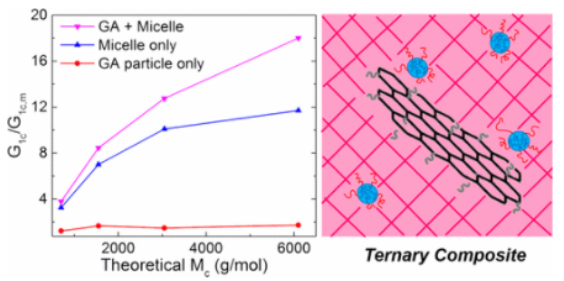Epoxy resins with improved toughness
A composite material made of epoxy combined with graphene and block copolymer for improved toughness.

Applications
- Adhesives - epoxy resin Epoxy resin based composite Epoxy resin based coatings (eg. anti-chip base coat for automotive)
- Significantly tougher: 19x tougher than unmodified material
- Comparable elastic modulus of the unmodified polymer matrix
- Tunable cross link density and mechanical properties
- License
- Sponsored research
- Co-development
- Frank Bates, PhD, Professor, Chemical Engineering & Material Science
- Lorraine Francis, PhD, Professor, Chemical Engineering & Material Science
Key Benefits & Differentiators
Overview
Glassy thermosets, such as epoxy, are brittle and lack the mechanical toughness needed for many applications. Traditional toughening strategies for epoxy thermosets can be roughly classified into two categories: 1) modification with soft additives, including liquid rubbers and amphiphilic block copolymers; And 2) modification with rigid fillers, like silica particles, carbon nanotubes, clays, and graphenes. Both categories have their limitations.
Researchers at the University of Minnesota have developed a novel composite material with exceptional mechanical performance using graphene, block copolymer and epoxy. This material is prepared by combining a rigid platelet-shaped filler that is micron-scaled in the lateral dimension, and a soft filler that is nano-scaled to toughen a thermoset polymer matrix. Specifically, this material is made of (i) amphiphilic block copolymer with an epoxy miscible block and an epoxy immiscible block; (ii) resin material; and (iii) amine modified graphene oxide. Researchers have shown that the resultant hybrid composite exhibits a superior toughness that is higher than the combined toughening resulted from solitary modifiers. Furthermore, the elastic modulus of the hybrid composite is retained as that of the unmodified polymer matrix. Lastly, the crosslink density of the composite is tunable, thereby enabling adjustable mechanical properties.
Phase of Development
TRL: 4Experimental characterization in a lab/emulated environment.
In the epoxy matrix with the lowest crosslink density, 5 wt.% block copolymer and 0.04 wt.% graphene modifier together enhanced the critical strain energy release rate (G1c) to 19 times that of the unmodified material. Mechanical and thermal characterization of the hybrid composite confirmed the presence of synergistic toughening effect in a model epoxy system with low crosslink density and also in a commercially viable epoxy thermoset with a block copolymer that is commercialized product (FORTEGRA 100).
Desired Partnerships
This technology is now available for:Please contact our office to share your business’ needs and learn more.
Researchers
-
expand_more library_books References (1)
- Li, Tuoqi, Siyao He, Andreas Stein, Lorraine F. Francis, and Frank S. Bates. , "Synergistic toughening of epoxy modified by graphene and block copolymer micelles.", Macromolecules 49, no. 24 (2016): 9507-9520.
-
expand_more cloud_download Supporting documents (1)Product brochureEpoxy resins with improved toughness.pdf